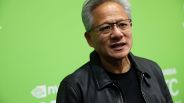
The wearable technology market is rapidly maturing, moving beyond early-adopter gadgets to become a mainstream fusion of fashion and functionality. In the competitive smart eyewear space, where companies like Amazon and Meta are vying for consumer attention, success now hinges on creating a seamless user experience that feels both intuitive and aspirational. This requires a holistic creative vision that integrates product design, brand narrative, and performance marketing into a single, cohesive journey.
Liliia Yuzkova, Creative Director at Lucyd Smart Eyewear, is at the forefront of this shift. With over a decade of experience shaping campaigns for global brands like Nestlé and Vodafone, she now leads the creative strategy for Lucyd's licensed smart eyewear lines, including Reebok, Nautica, and Eddie Bauer.
Yuzkova's approach shows how an understanding of the consumer journey, backed by data analysis, can help make a technologically advanced product an integral part of a user's daily life.
Orchestrating the Brand Experience
Launching a new piece of smart technology requires more than just showcasing its features; it demands the creation of an entire ecosystem around the product. For a device meant to be worn daily, this process begins by understanding its place in a user's world from both a physical and cultural perspective. This foundational work is crucial for building an authentic connection with the consumer.
"Every new campaign begins with a deep dive into the brand's DNA and the cultural context in which the product will live," she states. This involves mapping out the entire consumer journey, from the first online ad to the final unboxing.
By establishing a clear creative direction early, this process ensures every touchpoint is consistent. This strategy was showcased when Lucyd produced the first AI-generated eyewear runway show, a move that aligned the brand's innovative DNA with a culturally relevant technological trend.
This comprehensive approach is essential for a market where products are increasingly defined by their software and integrated services, such as smart glasses that support Large Language Models and voice assistants. "This holistic approach transforms a new product launch into an orchestrated brand experience, where each detail reinforces Lucyd's identity and innovation," Yuzkova adds.
Designing the First Interaction
In e-commerce, the packaging is often the first tangible interaction a customer has with a brand, making it a critical moment in the user experience. This physical touchpoint carries the responsibility of conveying quality, innovation, and brand identity before the product is even revealed. It must be both protective and evocative, balancing practical needs with emotional resonance.
"Packaging is often the first physical interaction with our brand, so it carries a powerful responsibility," explains Yuzkova. She treats packaging as a direct extension of the smart eyewear itself, using tactile materials and refined visuals to elevate the unboxing experience.
This design philosophy is critical when competing with products that have varying approaches to accessories, from the Ray-Ban Meta's charging case to the simpler transport case of Amazon's Echo Frames. The design must also account for functional elements like protection and cost-efficiency without compromising the premium feel.
Factoring in practical considerations such as a product's stated 12-hour battery life informs the entire product ecosystem, including its packaging. "By merging functional needs with elevated design choices, I ensure Lucyd's packaging does more than safeguard eyewear—it reinforces the brand's positioning as a premium leader in wearable tech," she notes.

Balancing Art with Science
In a digital marketplace, creative decisions cannot be based on instinct alone. Effective brand strategy requires a data-driven approach where design choices are tested, measured, and refined. A/B testing, a cornerstone of this process, allows creative teams to move beyond subjectivity and understand what truly motivates consumer behavior.
"I treat A/B testing as both science and art," says Yuzkova. Her process involves developing creative variations based on specific hypotheses—testing different color palettes, messaging, or imagery to see what drives the most engagement. This aligns with the principles of iterative design, which structures development around cycles of prototyping, testing, and analysis.
An unexpected insight emerged during the launch of Lucyd Armor smart safety glasses. Testing revealed that a combination of lifestyle photos and technical renderings was the most effective approach. "This unexpected insight reshaped our strategy, showing that the most persuasive campaigns combine human relatability with technical clarity," Yuzkova explains, a conclusion supported by findings that interactive formats like AR can boost brand recall by 70%.
Shaping Creativity with Data
Evaluating the success of a campaign requires looking beyond surface-level metrics like likes and shares. To build a sustainable growth strategy, creative leaders must focus on performance indicators that directly impact business outcomes, using that data to inform and justify subsequent creative iterations.
"I focus on metrics that go beyond surface-level engagement," Yuzkova states. "Click-through and conversion rates are critical, of course, but I also study dwell time, cost-per-acquisition, and repeat customer behavior." These numbers provide a deeper understanding of a campaign's influence on purchasing decisions and long-term loyalty.
This detailed analysis is key to tying engagement to outcomes like site traffic and sales lift, which demonstrate tangible business impact. "This data-driven creative loop ensures every campaign becomes more targeted and impactful than the last," she adds. Tools like the Brand Lift Study and Marketing Mix Modeling provide the statistical framework to validate these creative adjustments.
Bridging Technology and Humanity
For smart eyewear to achieve mass adoption, its narrative must transcend technical specifications and connect with the human experience. The most successful campaigns are built on user-centric storytelling, demonstrating how the product seamlessly integrates into and enhances daily life. This requires shifting the focus from features to benefits.
"Storytelling is the bridge between technology and human connection," Yuzkova says. "With smart eyewear, the narrative isn't just about advanced features—it's about how the product empowers everyday life." This contrasts with approaches that heavily emphasize a single function, such as the hands-free Alexa integration in Amazon's Echo Frames.
By grounding campaigns in relatable scenarios, the technology becomes both accessible and aspirational. This is especially important as AI integrations become more model-specific and diverse.
"Customers don't just see a product; they see themselves using it," she explains. "This emotional connection is what drives higher engagement and conversion rates."
Adapting to Platform Behaviors
Maintaining brand consistency across multiple e-commerce channels is a significant challenge, as each platform has its own user expectations and content formats. A one-size-fits-all approach is ineffective. The key is to establish a strong core brand identity that can be flexibly adapted to feel native to each environment.
"My approach is to define a strong creative core—visuals, tone, and messaging that clearly reflect Lucyd's identity—and then adapt it to fit the behaviors of each channel," Yuzkova notes. For instance, Amazon prioritizes clarity and functionality, so creative assets there emphasize features and direct benefits, with success measured through models like Econometric Analysis.
On Meta, users respond more to lifestyle storytelling, so she leads with aspirational imagery to create an emotional connection. This adaptability ensures campaigns feel native to the platform while still unmistakably 'Lucyd.' By striking that balance, creative teams can build a cohesive brand presence that performs well across ecosystems, a performance that can be tied to incremental business outcomes.

Translating Vision into Functionality
In a technology-driven company, creative success depends on tight collaboration between design, data, and engineering teams. The creative director must act as a translator, ensuring that the brand's vision is executed in a way that is technically feasible, intuitive for the user, and aligned with measurable business goals.
"I see my role as both a creative leader and a translator—making sure that design intent aligns with technical feasibility and user experience," Yuzkova states. This involves working closely with data analysts to ground creative decisions in evidence and with product managers to align on business objectives. This process is validated by campaigns like Sephora's Snapchat initiative, which drove a 5.6% add-to-cart lift through integrated AR experiences.
By combining data, design, and technical execution, she helps ensure campaigns are not only visually compelling but also effective. This synergy is critical, as research shows that positive AR experiences can increase purchase intent by 19%. "Lucyd's campaigns are not only visually compelling but also intuitive and effective for the customer," she concludes.
Evolving for Emerging Technologies
The wearable tech landscape is in constant flux, with new hardware, software integrations, and user expectations emerging continuously. To stay relevant, creative principles cannot remain static. Design systems must be built for agility, allowing brands to highlight new technological advances in a way that feels intuitive and compelling to the consumer.
"In wearable tech, it's the product that must evolve most dramatically," Yuzkova observes. This requires an agile and iterative approach to design to keep pace. "My role as Creative Director is to ensure that marketing and design principles remain agile, adjusting to highlight these advances."
The most significant transformation is the integration of AI-powered tools into the creative process itself. "The biggest shift is how we leverage AI-driven tools: personalization, dynamic content generation, and predictive analytics are transforming how we tailor campaigns in real time," she says. This approach, measured by frameworks like Marketing Mix Modeling, ensures creative output reflects product innovation and meets user expectations.
The successful branding of wearable technology lies in a delicate balance between art and science. This human-centric approach suggests that the broad adoption of smart eyewear will depend not just on its technical capabilities but on how well it integrates into the user's life.
ⓒ 2025 TECHTIMES.com All rights reserved. Do not reproduce without permission.




